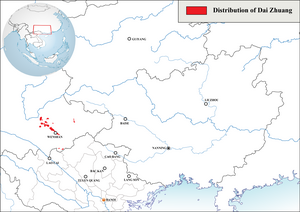|
文麻壯語
文麻壮语,又称岱壮语,是壮语的一种,属中部台语支,通行于云南省文山、麻栗坡、马关和开远等地,在红河州也有分布,最大的密度出现在文山市(一半壮族)和砚山县(壮族人口的20%)[3],使用人数约有10万人。 名称下面是指称文麻壮语使用者的不同外名与内名[4]:43。
方言与分布江子扬依调类分合的模式,将文麻壮语分为4种方言[4]。
在越南,Thu Lao语(自称:La Hừ,意为“黑土”)分布在下列7个村(Nguyễn 2014)。[5]:14
Jerold Edmondson将其描述为有约200人使用的中部台语支语言,保持了浊声母,这与高平省重庆县的岱依语很像。[6] 《云南民族识别综合调查报告》报告了一个台语族群,称作摆彝,生活在文山市、马关县和河口瑶族自治县桥头苗族壮族乡。该报告认为它和傣仂语很像。摆彝在河口被分为傣族,在文山和马关则被分为壮族。在1960年,摆彝人口有6958人。[7] 音系许多文麻壮语方言都保留了原始台语的浊塞音[8]。蒂拉班·琅东坎将有浊塞音的方言称为“Dai Tho”,没有的是“Tai Tho”。 另见
参考
阅读更多
|
||||||||||||||||||||||||
Index:
pl ar de en es fr it arz nl ja pt ceb sv uk vi war zh ru af ast az bg zh-min-nan bn be ca cs cy da et el eo eu fa gl ko hi hr id he ka la lv lt hu mk ms min no nn ce uz kk ro simple sk sl sr sh fi ta tt th tg azb tr ur zh-yue hy my ace als am an hyw ban bjn map-bms ba be-tarask bcl bpy bar bs br cv nv eml hif fo fy ga gd gu hak ha hsb io ig ilo ia ie os is jv kn ht ku ckb ky mrj lb lij li lmo mai mg ml zh-classical mr xmf mzn cdo mn nap new ne frr oc mhr or as pa pnb ps pms nds crh qu sa sah sco sq scn si sd szl su sw tl shn te bug vec vo wa wuu yi yo diq bat-smg zu lad kbd ang smn ab roa-rup frp arc gn av ay bh bi bo bxr cbk-zam co za dag ary se pdc dv dsb myv ext fur gv gag inh ki glk gan guw xal haw rw kbp pam csb kw km kv koi kg gom ks gcr lo lbe ltg lez nia ln jbo lg mt mi tw mwl mdf mnw nqo fj nah na nds-nl nrm nov om pi pag pap pfl pcd krc kaa ksh rm rue sm sat sc trv stq nso sn cu so srn kab roa-tara tet tpi to chr tum tk tyv udm ug vep fiu-vro vls wo xh zea ty ak bm ch ny ee ff got iu ik kl mad cr pih ami pwn pnt dz rmy rn sg st tn ss ti din chy ts kcg ve
